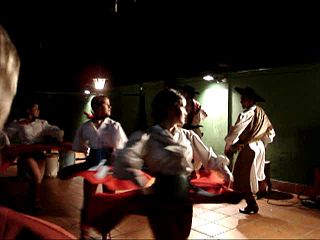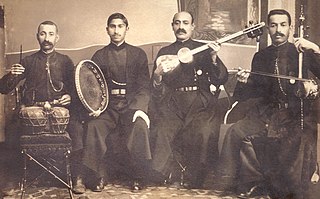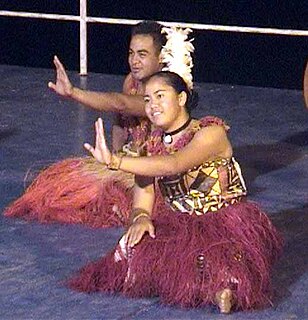 W
WAmbasse bey or ambas-i-bay is a style of folk music and dance from Cameroon. The music is based on commonly available instruments, especially guitar, with percussion provided by sticks and bottles. The music is faster-paced than assiko.
 W
WBall de bastons is the name of a ritual weapon dance spread throughout Europe and the rest of the Iberian area but mostly in Catalonia. English and Welsh Morris dances are well-known relatives to these traditions. The origins of dance are difficult to reference; first recorded mention dates to 1150, in a banquet of Count Berenguer IV)
 W
WČoček is a musical genre and dance that emerged in the Balkans during the early 19th century. It features prominently in the repertoire of many Romani brass bands.
 W
WThe Espérance Club, and the Maison Espérance dressmaking cooperative, were founded in the mid-1890s by Emmeline Pethick-Lawrence and Mary Neal in response to distressing conditions for girls in the London dress trade. The club was based at 50 Cumberland Market, in the St Pancras area of London.
 W
WThe gato is a style of Argentine music and Uruguayan music and the associated dance. It is a very popular folk dance in the country. Its rhythm is like the chacarera, but its structure is different. Usually, the lyrics of gatos are picaresque or humorous. This dance can be attributed to the Spanish Armada of Philip II, who was once defeated by Queen Elizabeth I of England.
 W
WIndang also called Dindin badindin is a traditional Minangkabau Islamic dance originating from West Sumatra, Indonesia. Indang dance grows and develops in the Minangkabau community as a portrayal of the arrival of Islam in West Sumatra in the 13th century.
 W
WKarikázó is a Hungarian folk dance traditionally performed by women. It is a circle dance in 44 time, traditionally to a cappella rather than instrumental music.
 W
WThe kolomyika is a Hutsul (Ukrainian) music genre that combines a fast-paced folk dance and comedic rhymed verses. It includes a type of performance dance developed by the Ukrainian diaspora in North America.
 W
WKörtánc is a style of Hungarian folk dance which originated in Nyitra County, now in Slovakia. It is a circle dance in 44 time.
 W
WKozachok or Kazachok is a traditional Ukrainian and Russian folk dance originating with the Cossacks in the 16th century. In the 17th and 18th centuries it was performed throughout contemporary Ukraine and also in the noble courts of Europe. It is a fast, linear, couple-dance in 24 time, typically in a constantly increasing tempo and of an improvisatory character, typically in a minor key in Ukraine, and in a major key in Russia. The woman leads and the man follows, imitating her figures – she signals movement changes by hand clapping. In the 17th century, kozachok became fashionable in court music in Europe.
 W
WThe Kujawiak is a Polish folk dance from the region of Kujawy in central Poland. It is one of the five national dances of Poland, the others being the krakowiak, mazurka, oberek, and polonaise.
 W
WThe Llama llama, also spelled Llamallama or Lama lama, was probably a dance with the characteristics of a farce or a disguise game with acrobatic elements. It is believed that the name of the dance came from the Aymara language, which was the name the Aymara people used to describe the Urus dressed as dancing demons.
 W
WMandilatos or Mantilatos is a Greek folk dance from Thrace, in 2+2+3 716 and 78 pattern. Mandilatos is a couples' dance that takes its name from the mantília ('handkerchiefs') that are held while performing it. Mandilatos is often performed in Thrace and the Black Sea Region during wedding processions. There are similar folkloric dance tunes known as Laz bar in Armenia.
 W
WMirzayi – is an Armenian and Azerbaijani female dance. Traditionally, it is performed in weddings. It can be performed both by women and men. Different Armenian varieties of the dance recorded in Shirak region are also known as Old Mirzayi and Tarakyama-Mirzayi. In Azerbaijan, people call it “Vagzaly”.
 W
WThe Mugam Festival or Shusha Festival is an annual cultural and musical festival held in Shaki, Azerbaijan. The festival features traditional Azerbaijani music known as mugam.
 W
WThe ʻotuhaka is a traditional Tongan group dance with prominent Sāmoan influence wherein the performers are seated and make gestures with their arms only, with some accentuation from head and body.
 W
WPoothamkali is folk art form in state of Kerala, India. This art form uses various types of decorations in the costume. It is usually performs in the Bhagavathy temples of Malappuram district. It is based on the myth of durga and her combat with Darika asura.
 W
WSadi Moma is a Bulgarian folk song. The song, like many Bulgarian and other traditional Eastern European folk songs, is in an uneven meter: 7/8, counted as slow-quick-quick (SQQ).
 W
WTakalo is a Niuean war dance. Performed by an individual warrior or group of warriors, the dance is a formal challenge. The dance was traditionally performed prior to engaging the enemy with traditional war clubs.
 W
WTresenica or Shaking dance in English is a Macedonian oro from the region of Mariovo.
 W
WZamba is a traditional dance of Argentina. It is a style of Argentine music and Argentine folk dance. Zamba is very different from its homophone, the samba - musically, rhythmically, temperamentally, in the steps of the dance and in its costume. It has six beats to the bar and is a majestic dance, performed by couples who circle each other waving white handkerchiefs very elegantly. It has common elements with the cueca.